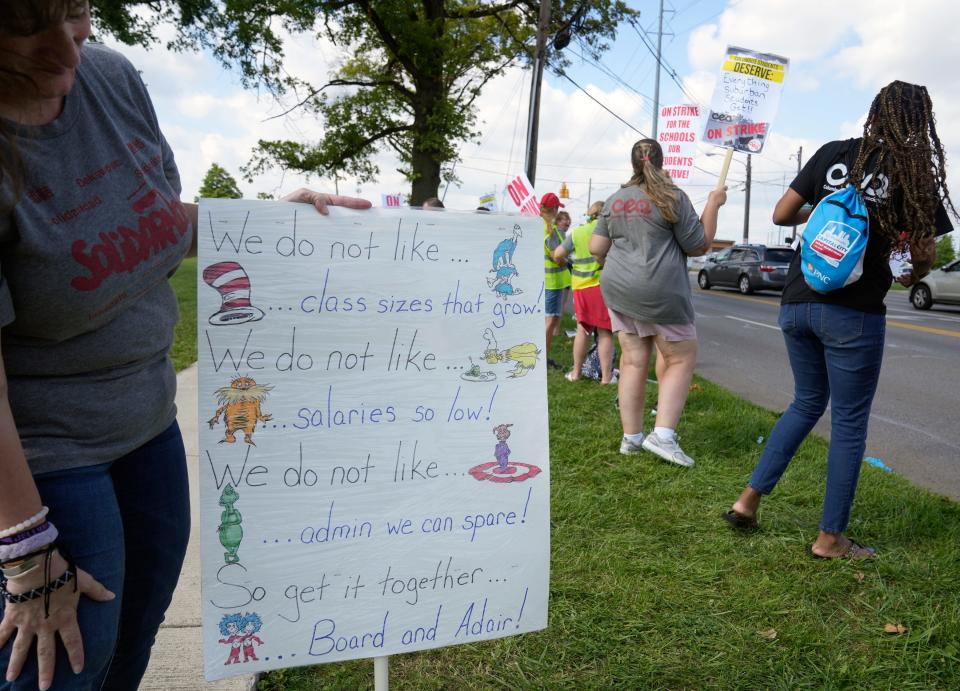How did this Columbus Education Association strike compare to the last one in 1975?
Hours after the Columbus Education Association and the Columbus City Schools Board of Education announced Thursday they had reached tentative agreement on a new contract, CEA Spokesperson Regina Fuentes talked about how the strike will be remembered.
“Let the history books reflect that this strike was about students who deserved a commitment to modern schools with heating and air conditioning, smaller class sizes, and a well-rounded curriculum that includes art, music and P.E.," Fuentes said.
Columbus City Schools strike:Timeline of contract talks between school district, Columbus Education Association
The union's nearly 4,500 members — largely teachers but also nurses, psychologists and other education professionals — voted Sunday to accept the proposed three-year contract. The school board was scheduled to ratify the deal at a special meeting this morning.
Union members were on the picket line for three days last week, and it was only the second strike held in Columbus City Schools history. CEA members went on strike for the first time in 1975.
A look back reveals that while these two strikes share some similarities, the differences are decided.

What prompted the 1975 strike?
On Jan. 4, 1975, after months of negotiations on a new contract and on the brink of a new school semester, talks between the union and school board stalled, according to reporting by The Dispatch at the time.
A "last ditch" negotiating session was held that Saturday between the parties in an effort to reach an agreement before the school year resumed in two days.
The CEA, which at the time represented 3,800 of the district's nearly 5,000 teachers, was asking for a 14.8% salary increase due to record-high inflation rates. The union eventually lowered its offer to 12%.
First-year teachers at the time made $8,070 a year, with the average teacher earning $11,500 annually. That would be $45,900 and $65,400 per year, respectively, in today's money, per the U.S. Bureau of Labor Statistics.
Columbus Board of Education members countered with a 4.08% increase.
By comparison, Columbus City Schools offered a 3% annual hike in each year of a three-year contract in its "last best, and final offer" before the teachers union voted to strike Aug. 21. The teachers union had early on in talks proposed 8% annually, but it was unknown what they settled on before the contract vote Sunday.
In 1975, then-federal mediator Joseph Santa-Emma said the two parties were "miles and miles apart" after their final two-hour bargaining session, according to The Dispatch.
The school board's negotiator at the time, Charles Hall, called the CEA's demands "ridiculous" and said "this package is no more possible (to pay for) than the last pact."
The next day, Sunday, Jan. 5, 1975, union members met at the Ohio State Fairgrounds for a strike vote. Of the members who attended the meeting, about 60% voted to reject the school board's offer and strike, according to The Dispatch.

Although majority voted to strike, some teachers crossed picket lines
"Hundreds of the city's 5,000 teachers traded blackboard pointers for picket signs," The Dispatch wrote onMonday, Jan. 6, 1975, the first day of the strike, "but many others crossed the picket lines to meet students returning from a two-week vacation.
Many teachers in the district still reported to the classroom that Monday, having disagreed with the strike. One elementary school teacher told The Dispatch that she planned to teach her students regardless of the union's vote.
Board officials at the time said the number of teachers who showed up to work varied. Five elementary schools reported perfect attendance, they told The Dispatch.
Most schools, though, saw low attendance.
Just 8% of teachers at the now-closed Thurber Elementary School on the city's North Side reported to work that day. Student attendance was mixed as well, the newspaper reported then.
Schools were kept open during the strike, and then-Columbus City Schools Superintendent John Ellis said the district had 600 substitute teachers ready to fill in where needed. (That's exactly the same number of substitutes the district said it had when it opened districtwide classes remotely on Wednesday while teachers were on their third and last day of picketing last week.)
Ellis told The Dispatch before the 1975 strike that "children absent from school during the strike would not be considered truant."
"If parents feel their children shouldn't come, we will respect that decision," he said.
Columbus City Schools officials took the exact opposite approach this strike, warning that students who didn't cross the "virtual picket line" and attend classes would be marked absent and that the district intended to enforce truancy laws.
But the district's current computerized attendance system automatically marked its approximately 47,000 students in attendance Wednesday and had to be manually overridden to show a student was absent. Parents whose children did not log on Wednesday raised questions about the system, and as of Friday afternoon Columbus City Schools had still not provided attendance figures for that day even after saying the numbers would be available Thursday.
Depending on who was doing the counting in 1975, anywhere from 75% to 95% of the district's 98,000 students at that time stayed home during the strike. Only 1% of students showed up for classes at the now-closed Milo Elementary School on Monday, Jan. 7, 1975, while 82% of students were in class at Kenwood Elementary on the Northwest Side, now Ecole Kenwood French Immersion.
Community reaction was mixed as well. At Sullivant and Milo elementary schools, parents served hot lunches to picketing teachers. At Pinecrest Elementary School in Clintonville, which is now closed, they provided hot food to teachers who showed up for work.
Ellis and then-School Board President Virginia Prentice had previously said that the district wouldn't invoke the Ferguson Act, an Ohio law that at the time prohibited any state public employee from striking. Using the law "would cause wounds that would take years to heal," Ellis told The Dispatch.
But as teachers picketed outside their classrooms that Monday, Jan. 7, 1975, the school board filed a lawsuit against the union claiming teachers violated the law. Franklin County Common Pleas Court Jay C. Flowers initially refused to end the strike, but did put limits on picketing so that it would not interfere with students attending classes. He ultimately ruled the strike illegal and required teachers to return to class, thus ending the weeklong strike.
What was the outcome of the 1975 strike?
About a month after the strike ended, teachers approved a contract that provided an immediate 6% pay hike, followed soon after by another 2% increase when then-Gov. James A. Rhodes signed a school funding bill into law, according to The Dispatch. Teachers were promised up to 5.4% more the following January, depending on the level of state support.
The late 1970s were "tumultuous and groundbreaking" for the CEA, according to the union's history, but the 1975 strike "solidified teachers’ commitment to fair treatment and administrative respect."
Neither of the CEA strikes came anywhere near setting records for duration.
The longest teachers strike in the history of Ohio was an 85-day strike by teachers in Ravenna in the spring of 1981. According to OhioHistoryCentral.org, teachers picketed not only outside of schools and the administration building but in front of school board members' homes and businesses.
An eight-month teachers strike in 1987 in Homer, Illinois, is the longest strike in U.S. history, reported OhioHistoryCentral.org. After roughly one month, the school board hired substitute teachers for much of the school year, and the strike remains a sore point in the community 35 years later.
shendrix@dispatch.com
@sheridan120
Sheridan Hendrix is a higher education reporter for The Columbus Dispatch. Sign up for her Mobile Newsroom newsletter here and Extra Credit, her education newsletter, here.
Online
For results of Sunday’s teachers union vote, visit Dispatch.com.
This article originally appeared on The Columbus Dispatch: How did Columbus teacher strikes in 1975 and last week compare?

